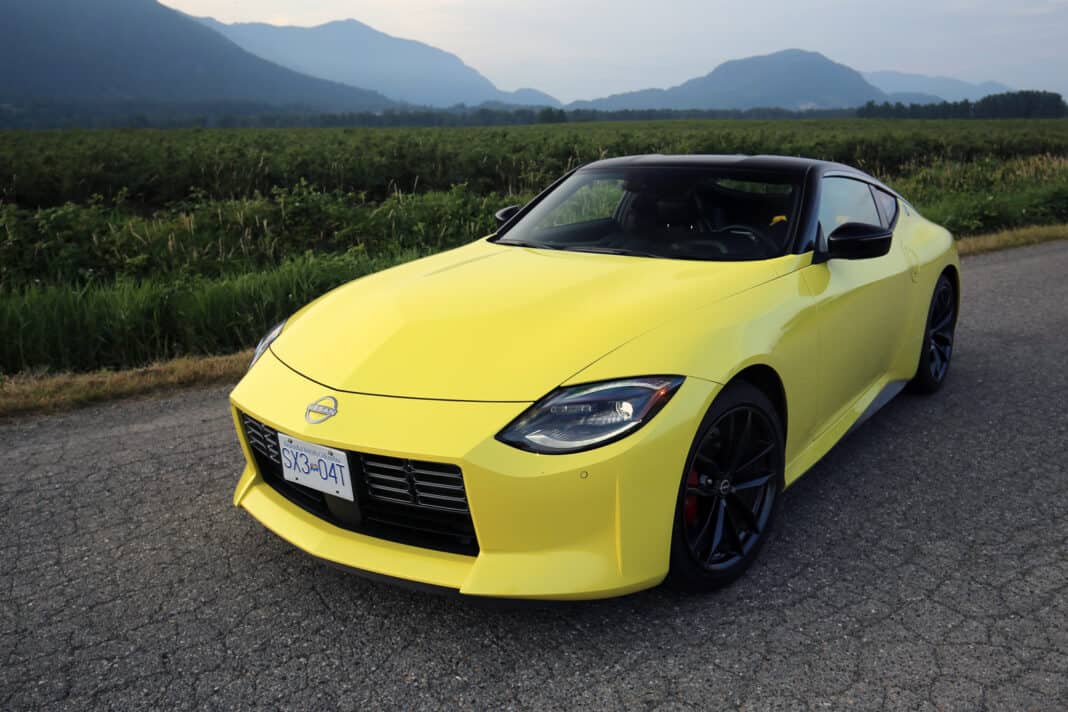When I was in elementary school in the 1970s, there was a significant shortage of petroleum products worldwide. As a result, North American consumers were looking for more fuel-efficient automobiles.
During this time, the Japanese car makers started to market many of their offerings to our shores, and North Americans began their long love affair with what proved to be very innovative and reliable cars. Most of the models that hit our shores were practical little runabouts, small pickups, and tidy wagons, but many buyers were still looking for something with more of a fun factor.
Related – Toyota GR Supra Vs. Nissan Z: BMW May Have Helped
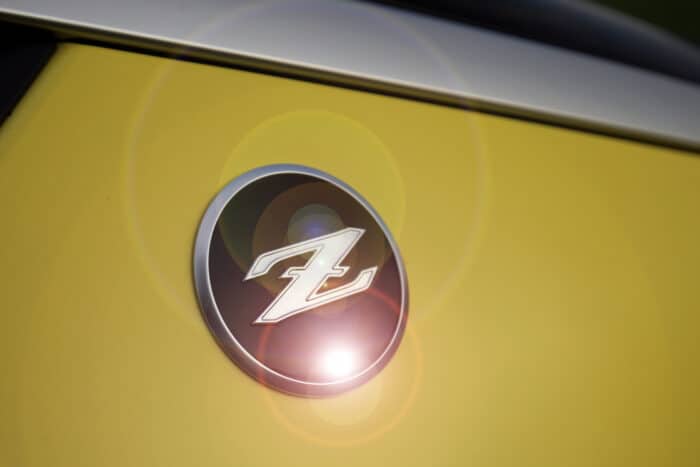
In stepped Datsun, the Japanese automotive giant (now operating as Nissan), with the 240Z, a budget-friendly sports car that appealed to enthusiast drivers who couldn’t afford to buy European offerings like Porsches and Jaguars, and didn’t want to break the bank at the gas pump filling up an American muscle car.
The 240Z was a lightweight two-seater with predictable handling and a beautiful, uncomplicated design. Larger displacement engines allowed the car to evolve through several guises (260Z and 280ZX) over the years and stretched variants with 2+2 seating for four.
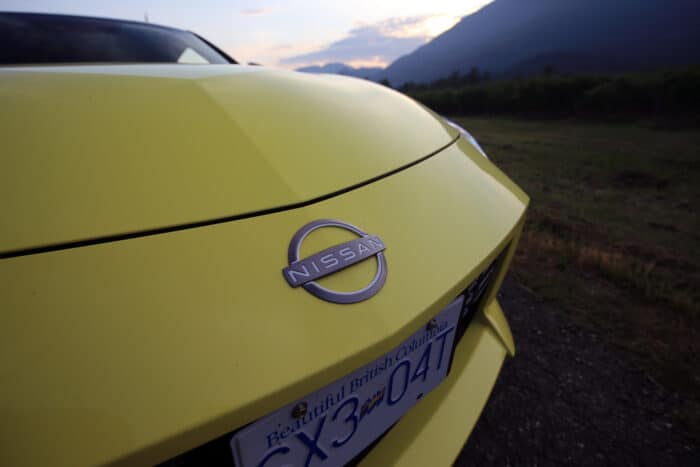
With the arrival of the Nissan nameplate came more comfort-minded models, beginning with the 300Z (two generations) and eventually the 350Z and 370Z. With over half a century of evolution, the cars became more complicated and technology-driven, but the fun factor was always a constant, so Nissan’s most sporting models have cultivated a large following.
New 400Z Styling Derived from its Many Forbearers
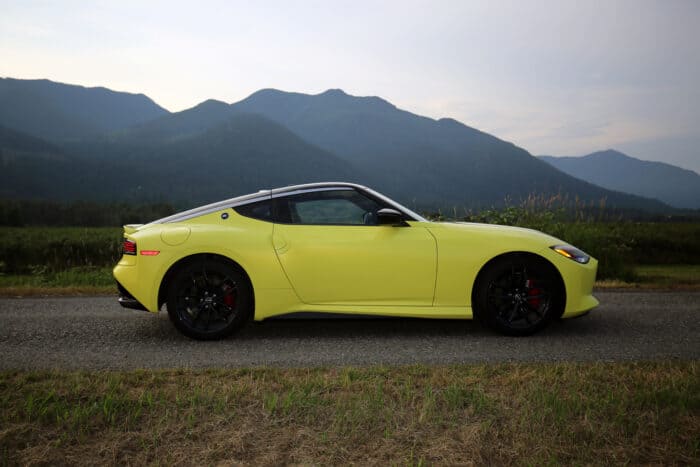
The 2023 Z features an all-new body that contains styling cues and elements derived from its many forbearers. The overall shape is immediately recognizable as an update of the 370Z, but the side profile has hints of 240Z, especially with regard to the shape of the greenhouse and placement of the trim.
Not to be forgotten, the front and rear fascias hint at both generations of the 300ZX. The wheelbase remains the same as that of the 370Z, but the new Z is almost 6-inches longer. The look is current, aero-efficient, and definitely an evolution of what Nissan customers like in a sport-minded machine. Here’s a closer look at how the new Z pays homage to its iconic ancestors.
400Z Performance Engine & Power
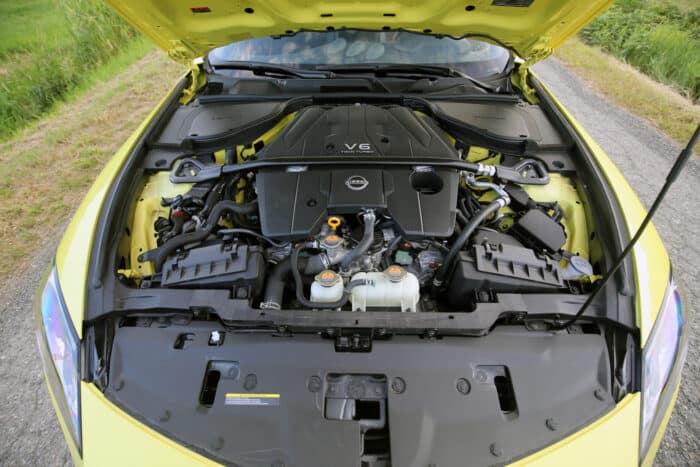
- Engine: 3.0L twin-turbocharged V6
- Horsepower: 400 @ 6,400 rpm
- Torque (lb-ft): 350 @ 1,600 rpm
- Transmission: 6-speed manual
- Brakes: Six-piston ventilated front disc / four-piston ventilated rear disc
There are two trim packages for this car, Sport and Performance, but both feature the same engine and your choice of either a 6-speed manual or a 9-speed automatic transmission. The motivation for this dynamic machine is provided by a twin-turbocharged 3.0-litre V6 engine that features direct injection and a significant bump in power over the mill that powered the outgoing 370Z. This smooth-revving engine produces 400 horsepower and 350 lb-ft of torque, up from 332 and 270, respectively.
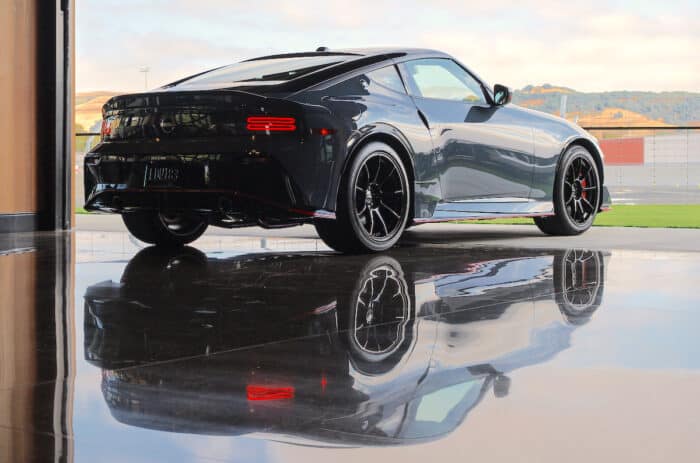
Need more power? The return of the Z NISMO for 2024 brings 420 horsepower and 384 lb-ft of torque to the party. Plus, other track-tuned features include improved handling, better wheels, enhanced aerodynamics & more.
The Z Performance with Manual Transmission

Our test unit was the Performance model with the manual transmission, which features a lightweight carbon-fibre driveshaft and a limited-slip rear differential. As you row through the gears the fast-spooling turbines build up the boost and allow you to execute 0-100 km/h runs in sub-five second times all day long, and with a little more effort and the use of the on-board launch control, I suspect that low four-second runs could be achieved.
Handling Impressions
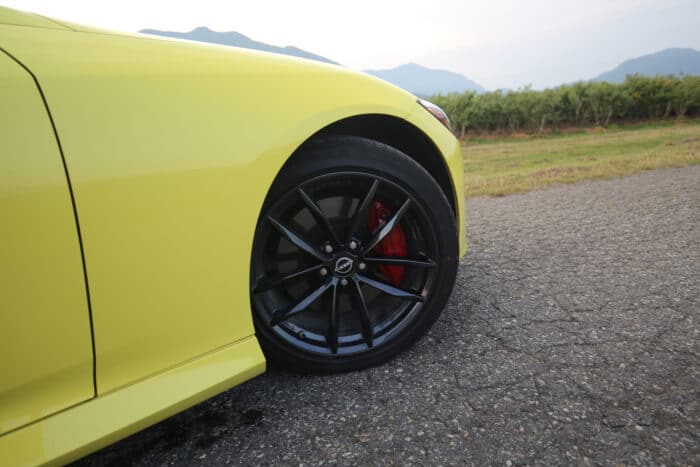
Like all Z cars before it, the latest version retains the front-engine, rear-wheel-drive layout that still remains the favourite combination for most driving purists, and when equipped with the close-ratio manual transmission, this car becomes truly special. Despite tipping the scales almost 70 kilograms more than a similarly equipped 370Z, the Z feels light and nimble, largely due to its near perfect weight balance (55 front/45 rear).
The new electric power-assisted steering is quick to react, but it also robs the driver of some of the feeling Z owners tend to relish when it comes to car control.
The new electric power-assisted steering is quick to react, but it also robs the driver of some of the feelings Z owners tend to relish when it comes to car control. The car is a blast to drive through switchbacks and technical corners, but you will need to focus a little more during execution as your butt will alert you to the first hints of over-steer before the steering wheel does.
Maintains traction well in a straight line
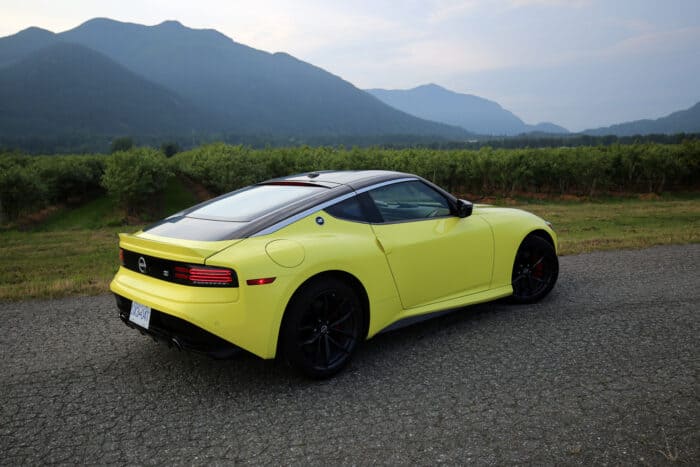
Under hard acceleration, the car will sit back on its haunches, pushing you deep into the seat before hustling forward with ease. There is little drama as the car maintains traction well in a straight line, and the nose quickly settles down as you ease up on the accelerator. Surprisingly, there are no driver-selectable performance modes in this car to adapt the traction control, throttle, or other dynamic parameters. The traction control is either on, or off.
Performance trim package adds Rays wheels, Bridgestone Potenza tires, and better brakes
Performance offerings also benefit from larger Nissan Performance brakes front and rear, which proved to be very efficient and virtually fade-free. A set of super lightweight, forged, 19-inch wheels from renowned motorsport supplier Rays wrapped in high-performance Bridgestone Potenza tires is also part of the Performance trim package, and these black beauties should prove robust given the company’s racing heritage.
Interior designed to enhance driver efficiency over comfort
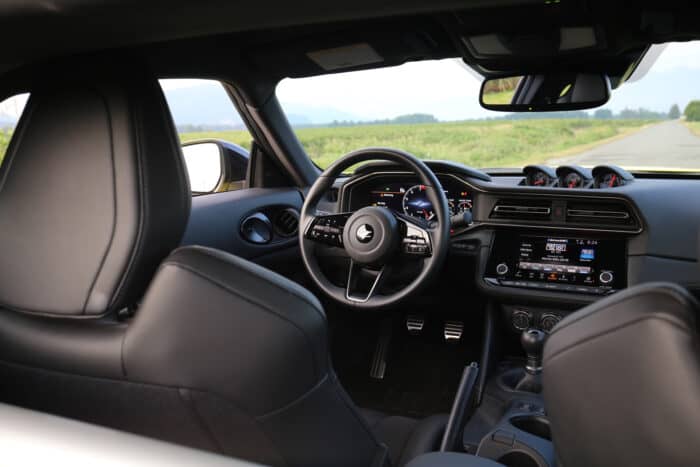
The interior of the Z has definitely been designed to enhance driver efficiency, so comfort is somewhat of an afterthought, especially for taller individuals. The deep-bolstered sport seats performed well during enthusiastic driving, but I am not sure if they would be welcome on an extended road trip. I must be getting old. They are heated, as is the sport steering wheel, the latter which has secondary controls for many of the car’s infotainment features.
In the cockpit and new virtual instrument cluster
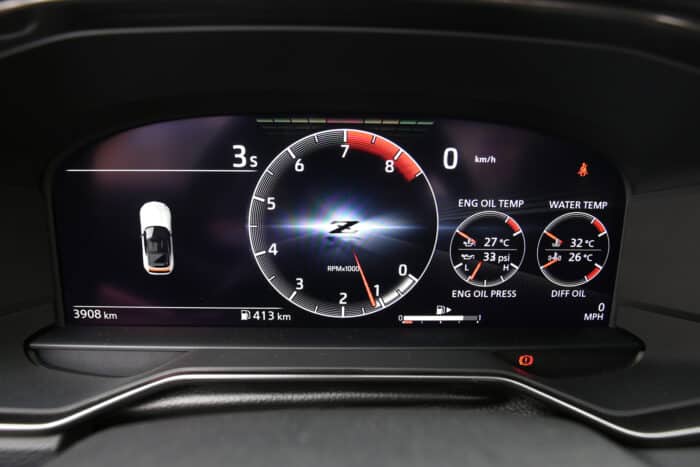
From the driver’s seat visibility is just okay, but that comes with the territory in long hood – hatchback designs, but all the important controls and switchgear are readily at hand. The new virtual instrument cluster is a terrific upgrade, as the gauge faces and shift lights really take centre stage like in a modern race car. Atop the dash sit three secondary gauges (a nod to the original 240Z) to allow you to monitor performance vitals like turbo boost, turbine speed, and voltage.
The design and layout of the centre stack is simple, and uncluttered, with efficient vent placement and large rotary knobs for the ventilation system. A wide touch-screen infotainment system allows you to enjoy the premium Bose audio system, monitor the camera system, or access Apple CarPlay or Android Auto.
Takeaway
Pros:
- Traditional rear-wheel drive and manual transmission combination make for an engaging driving experience.
- The 3.0-litre turbocharged V6 engine is both smooth and responsive.
- Nissan’s manual transmission utilizes SynchroRev Match to adjust the throttle to the ideal engine during downshifts.
Cons:
- The new electric power-assisted steering is quick to react, but it also robs the driver of some of the feelings Z owners tend to relish regarding car control.
- The car seems to be missing the audible punch that is usually associated with a sports machine. The engine and exhaust need to produce more bark.
The latest Z hearkens back to a time when the act of driving was the most important factor when it came to buying a sports car, not luxurious appointments and superfluous gadgets. Enthusiast drivers sought something quick, fun to drive, and with lots of curb appeal. I think Nissan has delivered this to us with the latest Z, complete with a manual transmission, and at a very competitive price.
2023 Nissan 400Z Performance Specs
| Spec | Metric |
|---|---|
| Engine | VR30DDTT 3.0L V6 Twin Turbo |
| Transmission | – 6-speed close-ratio manual w/EXEDY high-performance clutch – 9-speed auto w/drive mode switch, shift by wire Paddle shifters (9AT) |
| Drivetrain | Mid-mounted front-engine / rear-wheel drive |
| Power | 400 hp @ 6,400 rpm |
| Torque | 350 lb-ft @ 1,600 – 5,200 rpm |
| Max. engine speed | 6,800 rpm |
| Max. boost pressure | 15 psi |
| Induction system | Twin turbochargers |
| Valvetrain | 4 valves per cylinder; Continuously Variable Valve Timing Control System (CVTCS) |
| Exhaust | Sport: Dual w/ chrome finishers Performance: Dual w/sport grade muffler |
| Front suspension | Double-wishbone aluminum suspension High vacuum diecast aluminum alloy |
| Rear suspension | Independent multi-link aluminum suspension Steel |
| Standard wheels& tires | Sport: Dark-painted aluminum-alloy. Front: 18×9 inches Rear: 18×9 inches (Yokohama ADVAN Sport high performance tires) Performance: RAYS super lightweight forged aluminum-alloy. Front: 19×9.5 inches Rear: 19×10 inches (Bridgestone Potenza® S007 high performance tires) |

